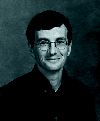
This represents an acceleration gradient that is a thousand-fold gain over the steepest gradients of the microwave-based technology used in today’s particle accelerating machines. For example, at the rate of acceleration achieved by Leemans and his colleagues, the same 50 GeV (billion electron volts) energies reached by electrons in the approximately 3,000 meters long world-renowned linac at Stanford, could be reached in less than two meters of plasma.
"In our present phase, we are generating electron beams
using a one millimeter acceleration distance with energy and amount of charge
approaching what the ALS linac does in over five meters," says Leemans.
"What sets our results apart from the laser-plasma acceleration experiments
of other groups is that we have produced the beam at a significant repetition
rate, allowing us to carry out radioisotope production experiments."
WIM
LEEMANS
![]()

Belgium-native
Wim Leemans is an engineer by training. He earned his
undergraduate degree in engineering from the Vrije Universiteit
in Brussels, then came to California where he obtained
a masters and Ph.D. in electrical engineering from UCLA.
Plasma physics, however, has been the focus of his scientific
interests—he received the 1992 American Physical
Society’s Simon Ramo award for outstanding thesis research
in this field. Wim now heads the group at Berkeley Lab’s
Center for Beam Physics known as l’OASIS which stands
for Laser Optics and Acceler-ator Systems Integrated Studies
![]()
Laser-plasma acceleration works along the same principles as water-surfing. Just as surfers catch and ride ocean waves into shore, electrons can be made to catch and ride the waves created in the wake of a pulse of laser light speeding through a plasma. The trick is to catch the right wave at just the right moment.
At the Center for Beam Physics, Leemans and his colleagues work with femtosecond time-scale (millionths of a billionth of a second) pulses of light that can be delivered at 8 to 10 terawatts of peak power and a 10 cycles per second (hertz) repetition rate. Laser-plasma acceleration experiments elsewhere have worked on a pico-second (trillionths of a second) time-scale at repetition rates that ranged from once a minute to once every 20 minutes.
In their last round of experiments, Leemans and his colleagues used a pulse of femtosecond laser light to heat a gas jet of helium atoms thousands of degrees until the electrons were set free and the gas became a plasma. This same pulse of light also drove a gigantic traveling wave through the plasma that Leemans likens to a "tsunami." Large numbers of the free electrons in the plasma get caught up and carried in this tsunami to high energies but there is little control over the mean energy of the emerging beam.
"Spatially, the beam is well-behaved with a well-defined footprint," says Leemans, "but the energy spread is so wide—essentially 100-percent—that what we get is more like a spray of electrons."
To overcome the energy spread of their electron beams, Eric Esarey, who leads the theoretical effort for this project, has devised a scheme he calls "the colliding pulse injection method." This scheme is currently being implemented by Leemans and the experimentalists. It calls for the use of four separate pulses of light (all from the same laser) for every single bunch of electrons that are to be accelerated. As before, an initial pulse produces the plasma. A second blast of light then drives a large amplitude wave, corresponding to tens of gigavolts per meter, that moves at nearly the speed of light—too fast for the slow plasma electrons to catch it. Behind this second "driving" pulse of light, however, a third and fourth pulse of light will be sent simultaneously into the plasma from opposite directions.
When these two pulses cross paths at some distance behind the drive wave, they form a "beating pattern" of smaller waves that speed up the electrons in the plasma, enabling them to catch the fast-moving drive wave and ride it to high energies.
"The effect of the energy boost we will give to the electrons (with the third and fourth pulses of light) is much like the paddling or swimming a surfer must do to catch a wave," says Leemans. "The time at which the boost is provided is, of course, very critical, just like it is for a surfer."
Since the beating pattern created when the third and fourth pulses of light meet occurs in a time-gated fashion, it can, through precise timing, be positioned to occur on the "right" phase of the drive wave so that the final product will be a very high quality electron beam with minimal energy spread and emittance.
Although Leemans and his colleagues are using laser-plasma acceleration to energize electrons, the technique can also be used to create high energy protons. When a pulse of laser light ionizes a solid foil into a plasma, an extremely strong electrical field is created by all those free electrons. After the electrons have been accelerated out of the plasma what remains is a highly-charged field of protons ready for acceleration.
Plasmas are a notoriously difficult medium with which to work and the idea of laser-plasma acceleration was initially greeted with skepticism by some prominent accelerator experts. However, says Swapan Chattopadhyay, who heads the Center for Beam Physics, "The first step to producing an accelerator beam is to control the entrance and the exit of your electrons. This is something we have already begun to demonstrate." — Lynn Yarris
|
Next > | |||